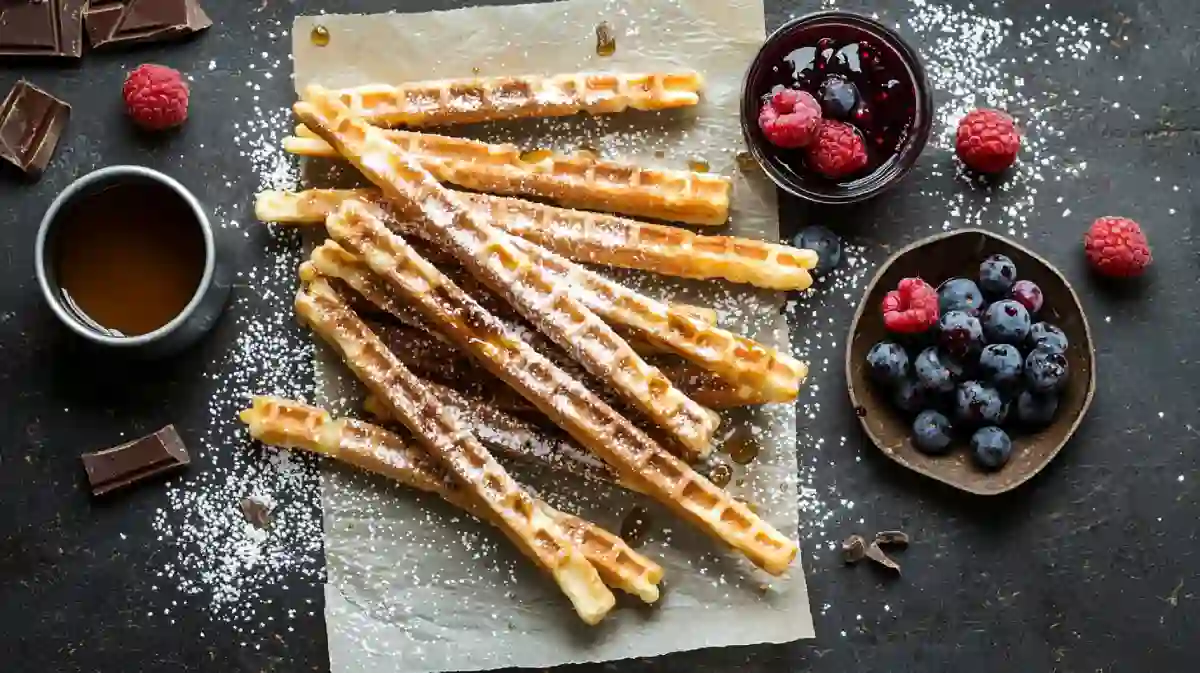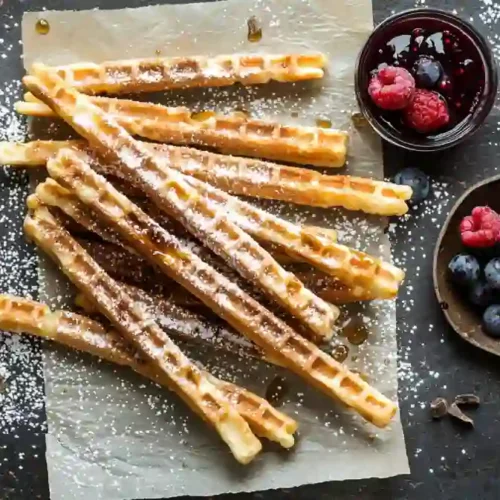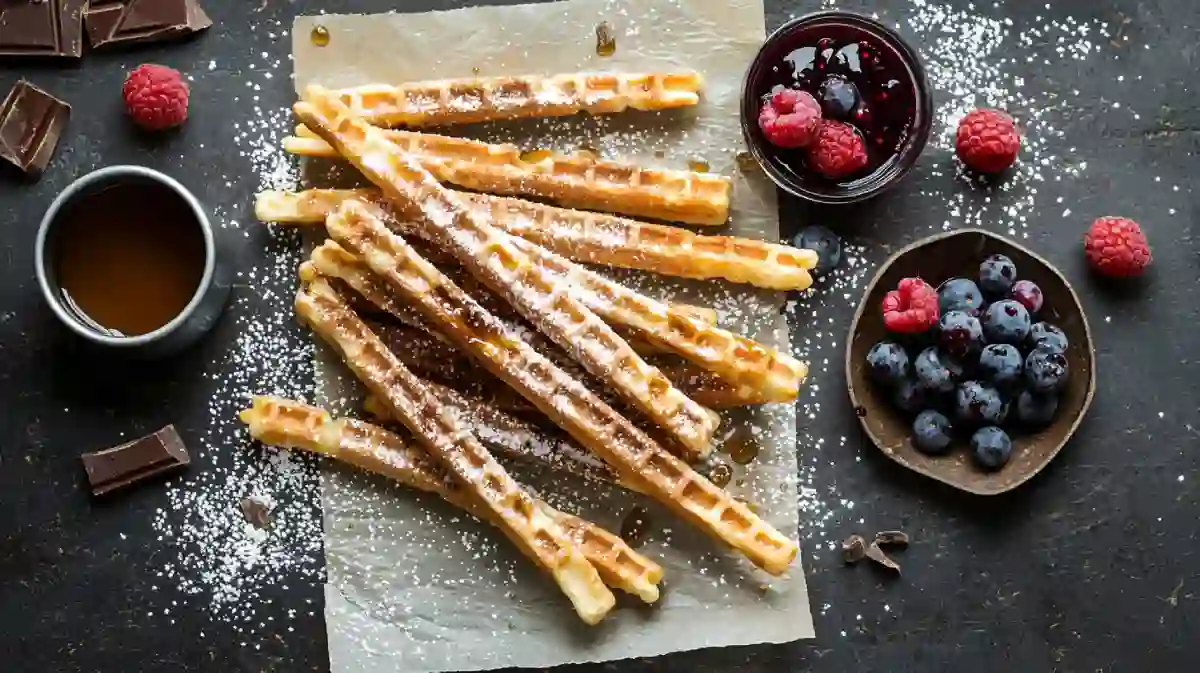
Table of Contents
Craving breakfast you can eat like fries? Waffle sticks bake up crisp outside, fluffy inside, and—after four batter tweaks—I found the sweet spot that keeps every stick sturdy enough for dunking yet tender at first bite. Ready in 15 minutes, they’re perfect for kids, brunch boards, or late-night snacks.
What Are Waffle Sticks?
Waffle sticks are a delightful variation of traditional waffles, designed to offer convenience and a unique eating experience. Shaped into long, slender sticks, they are easy to hold and perfect for dipping. This makes them an excellent choice for on-the-go breakfasts, kid-friendly snacks, or party treats.
Unlike regular waffles, which are typically served with cutlery, Waffle sticks are meant to be eaten with your hands. This difference not only adds to their fun appeal but also enhances their practicality. For instance, their shape allows them to fit easily into small containers or snack packs, making them ideal for school lunches or travel.
Moreover, waffle sticks cater to a variety of tastes and preferences. While traditional waffles are often associated with breakfast, these sticks can transition seamlessly from a morning meal to an evening dessert. For those who love creative culinary twists, adding flavors like cinnamon sugar, chocolate chips, or savory herbs can transform waffle sticks into something extraordinary. To explore similar versatile recipes, you can check this guide to creative snack recipes.
The ability to customize waffle sticks makes them a favorite in many households. Whether you’re preparing a batch for a quick breakfast or an elaborate brunch, their ease of preparation and wide appeal make them a go-to option.
How to Make Waffle Sticks at Home
Creating waffle sticks at home is both easy and rewarding. With the right tools and ingredients, you can prepare a batch that is fresh, delicious, and perfect for any occasion. Follow this step-by-step guide to make your own:
Ingredients:
- 2 cups all-purpose flour (swap with whole wheat for a healthier version)
- 1 tablespoon baking powder
- 1/2 teaspoon salt
- 2 tablespoons sugar
- 2 large eggs
- 1 1/2 cups milk (or almond milk for a dairy-free option)
- 1/4 cup melted butter (or vegetable oil)
- 1 teaspoon vanilla bean
Instructions:
- Prepare the Waffle Maker
Preheat your waffle maker and grease it lightly with butter or non-stick spray. Proper preheating ensures the batter cooks evenly, resulting in golden-brown waffle sticks. - Mix Dry Ingredients
In a medium bowl, combine flour, baking powder, salt, and sugar. Whisk them together to remove any lumps. - Combine Wet Ingredients
In another bowl, beat the eggs and mix in milk, melted butter, and vanilla bean. - Create the Batter
Gradually add the wet ingredients to the dry ingredients. Stir until the batter is smooth, but avoid overmixing as it can make the waffle sticks dense. - Cook the waffle sticks
Pour the batter into the waffle maker, filling each section evenly. Close the lid and cook for 3–5 minutes or until the waffle sticks are golden and crispy. - Serve and Enjoy
Remove the waffle sticks carefully and serve them with your favorite toppings or dips. Popular choices include maple syrup, chocolate sauce, or fresh fruits.
Serving Ideas and Pairings
When it comes to serving waffle sticks, the possibilities truly are endless. Whether you’re planning a festive party, preparing a cozy family breakfast, or crafting a quick snack platter, there are countless ways to elevate your presentation. By incorporating thoughtful pairings and creative touches, you can ensure any occasion becomes more memorable.
Serving Ideas
- Waffle Stick Platter
- To create an eye-catching display, arrange waffle sticks neatly on a large tray.
- Additionally, include small bowls of dips such as maple syrup, chocolate sauce, and fruit preserves to allow for customization.
- Furthermore, garnishing the tray with fresh berries or mint leaves can add a vibrant pop of color.
- Themed Waffle Party
- For an interactive option, consider hosting a DIY waffle bar where guests can select from a variety of toppings like whipped cream, nuts, and fresh fruits.
- Moreover, offering both sweet and savory options ensures there’s something for everyone to enjoy.
- Breakfast Boards
- To add variety, incorporate waffle sticks on a breakfast board alongside scrambled eggs and fresh juices.
- Similarly, pairing them with Greek yogurt and granola provides a balanced and nutritious spread.
Perfect Pairings
- Drinks
- To complement the waffle sticks, serve them with coffee, hot chocolate, or fresh smoothies.
- Additionally, for more formal occasions, mimosas or sparkling cider pair beautifully.
- Dips and Sauces
- Consider including a selection of dips like caramel, honey, or spiced yogurt for a well-rounded offering.
- Furthermore, adventurous eaters might enjoy a mustard-based dip made with the spiciest mustard seed, adding a bold twist to savory waffle sticks.
- Toppings
- For sweet lovers, options like Nutella, powdered sugar, or fresh fruit compotes are perfect choices.
- On the other hand, savory fans will appreciate shredded cheese, sautéed vegetables as flavorful additions.
By combining thoughtful presentation with an array of dips, toppings, and drinks, waffle sticks can easily become the centerpiece of any gathering. Moreover, experimenting with these serving ideas ensures every meal feels fresh and exciting. So, let your creativity shine and customize your setup to fit the occasion.
FAQs About Waffle Sticks
What Is the Best Way to Store Waffle sticks?
Let waffle sticks cool completely before storing to maintain freshness. They can be refrigerated in an airtight container for up to three days. For extended storage, freeze them first in a single layer on a baking sheet, then transfer to a freezer bag to prevent sticking.
Can Waffle Sticks Be Reheated?
Reheating waffle sticks is easy and helps restore their crisp texture. For best results, use an oven or toaster at 350°F for 5–7 minutes, whether they’re frozen or refrigerated. A microwave can be used for quicker reheating, but it may reduce their crispiness.
Are There Vegan or Gluten-Free Options for Waffle Sticks?
Vegan waffle sticks can be made by using plant-based milk like almond or oat milk and replacing eggs with flaxseed or applesauce. For a gluten-free version, substitute regular flour with gluten-free blends or alternatives like almond or oat flour. These changes preserve both texture and flavor while meeting dietary needs.
What Is Waffle?
A waffle is a batter-based dish made in a waffle iron, known for its crisp texture and grid pattern. Common ingredients include flour, eggs, milk, sugar, and baking powder. Varieties include Belgian, Liege, American, and Hong Kong egg waffles. They are served with sweet or savory toppings, such as syrup, fruit, or chicken, and are enjoyed worldwide as breakfast, dessert, or a savory meal.
Can I Use Pancake Mix for Waffle Sticks?
Pancake mix can be used to make waffle sticks effectively, though adding a bit more oil or butter to the batter helps achieve the crispiness typical of waffles. This simple adjustment enhances texture while keeping preparation easy.
What makes waffles stick to waffle iron?
To prevent waffle sticks from sticking, grease the waffle maker plates with oil or butter before adding batter. It’s also important to preheat the waffle maker fully to ensure even cooking and easy release.
When Were Waffle Sticks Discontinued?
Pillsbury Waffle Sticks, a beloved breakfast treat, were discontinued in the mid-2000s, roughly four years after their 2003 launch. The company did not specify reasons for the discontinuation, though market trends, competition, and production costs are likely factors. Fans continue to advocate for their return through petitions and social media campaigns, keeping the nostalgic product’s legacy alive.
What Happened to Waffle Sticks?
Waffle sticks were discontinued due to shifting consumer preferences toward healthier breakfast options, increased competition in the frozen food market, and potential production challenges. Their disappearance reflects evolving trends, but their legacy lives on through nostalgia and DIY recreations.
Conclusion
In conclusion, waffle sticks are more than just a fun variation of a classic breakfast treat—they are a versatile, customizable, and convenient option for people of all ages. Whether you’re serving them for breakfast, as a party snack, or as a quick dessert, their unique appeal lies in their adaptability to both sweet and savory flavors.
By using the right tools and ingredients, anyone can create delicious waffle sticks at home. Moreover, experimenting with toppings and dips can make each serving unique and exciting. From chocolate and fruit compotes to savory options like cheese and herbs, the possibilities are endless. If you’re aiming for healthier choices, incorporating whole grains or reducing sugar in the recipe allows you to enjoy them guilt-free.
Additionally, their portability and kid-friendly design make them an excellent option for busy mornings or family gatherings. Pair them with dips, drinks, or accompaniments to create a meal or snack that is both satisfying and memorable. Their ability to cater to diverse tastes ensures they remain a favorite for everyone, whether they’re prepared traditionally or with creative twists.
In short, waffle sticks offer endless opportunities for enjoyment. By embracing their versatility and using the tips shared in this guide, you can take your culinary creativity to the next level. So why not try making your own waffle sticks today and discover just how fun and delicious they can be? Let the journey of flavors begin!

Waffle sticks
Ingredients
- 2 cups all-purpose flour swap whole-wheat for extra fiber
- 1 Tbsp baking powder
- 0.5 tsp salt
- 2 Tbsp sugar
- 2 large eggs
- 1.5 cups milk dairy or almond for dairy-free
- 0.25 cup melted butter or vegetable oil
- 1 tsp vanilla bean/extract
Instructions
- Pre-heat & grease waffle maker.
- Whisk flour, baking powder, salt, sugar.
- Beat eggs; mix in milk, melted butter, vanilla.
- Pour wet into dry; stir just until smooth.
- Fill waffle plates; cook 3–5 min until golden.
- Lift out sticks; serve warm with dips or toppings.
Notes
- Swap 1 cup flour for oat flour plus 1 Tbsp flaxseed to boost fiber.
- Vegan: use plant milk + 2 Tbsp flaxseed meal (soaked) instead of eggs, and oil instead of butter.
- Gluten-free: replace flour with a 1:1 GF blend and add ½ tsp xanthan gum.
- Flavor twists: fold in ½ cup mini-chocolate chips, or ¼ tsp cinnamon + 1 Tbsp grated cheese for savory sticks.

